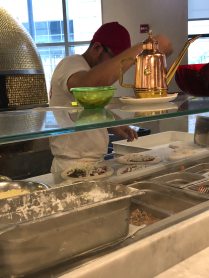Thanksgiving weekend is usually a four-day eat-a-thon and my favorite part is the leftovers. It’s not just turkey sandwiches and stuffing either, as it turns out when Thanksgiving Thursday hits, Wednesday naturally falls in place of Friday and we get faux Friday night pizza mid-week. So, along with my turkey-day leftovers, I’ve also got a fridge full of pizza.
As I’m lounging on the couch, feet-up, working up my next appetite I’m contemplating the cold beauty of the leftover slice. That amalgamation of cheese and toppings twisted into a cold statue of its former self, like Han Solo frozen in carbonite. The once contrasting textures of crispy crust, melty mozzarella, and pepperoni set into a savory pastry-esque version—a cool tomato sauce filling running beneath the surface that can rescue the mouth from the dryness of hardened cheese.
The paradox of leftover pizza.
I’ve found that the quality of leftover pizza often has little correlation with how good the original pizza was. Pizza in its piping-hot prime and a pizza a day-later can differ by a great deal. Some pizzas just don’t reheat well and are not enjoyable cold, while others can shine in their coagulated state.
For example, my favorite pizza of all time is Gus’ Pizza in Whitewater WI; Gus’ is super-thin square cut tavern-style at its finest. It’s a superstar fresh out of the oven, it’s crispy and greasy and cheesy, but it doesn’t hold up well the next day. It’s sauce to cheese ratio doesn’t make for the best cold slice and when you go to reheat it the chemistry is off (I would welcome pro reheating tips if someone has figured this out).
On the other hand, simple chain pizza like Pizza Hut pan style is outstanding cold. Tess swears by Dominos thin-crust cheese pizza leftover and will let it sit after it’s been delivered because she prefers it room-temperature or cold. That’s the paradox of leftover pizza. The pizza that’s the best at the pizzeria can be the worst leftover and the pizza you’d least expect like chain pizza can be the best later on. Luckily, sorting through this is quite enjoyable.

What’s the best leftover pizza?
What’s your favorite pizza? is my favorite question, therefore what’s your favorite leftover pizza? is my next favorite question. The perfect slice for breakfast will always be in the eye of the beholder but asking what’s your favorite leftover pizza? is a fun game to play and there is a lot to learn. Ording a pizza and doing your own research is even better.
With my mind in the thankful Thanksgiving mode, I realize there is a lot to appreciate in a day old slice. We get a second chance to experience our pizza. We get to enjoy a different set of attributes and can prepare it in a variety of ways. Leftover pizza is quite versatile as it’s great on the go, can be eaten hot or cold, can be enjoyed for any meal of the day or just as a snack.
What pizza taught me:
What I’m eating: Leftover Rosati’s-Super thin-crust, extra cheese half pepperoni, half green olive.
What I’m reading: The Effective Executive: The Definitive Guide to Getting the Right Things Done Peter Drucker





